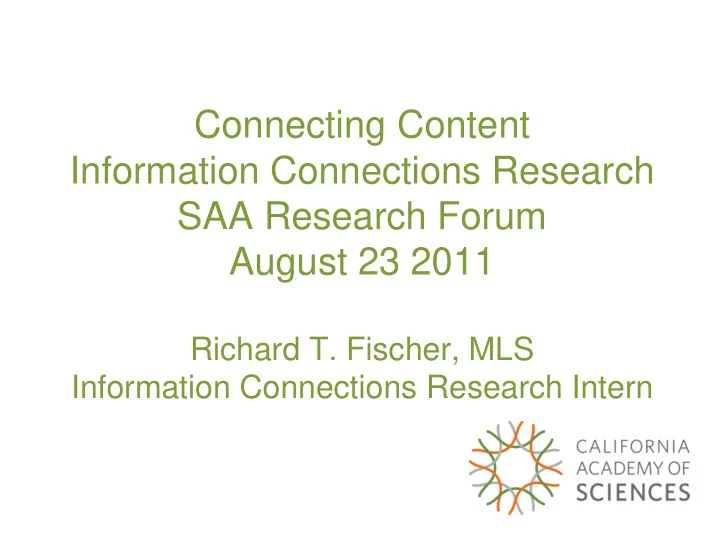

Connecting Content Information Connections Research SAA Research Forum August 23 2011 Richard T. Fischer, MLS Information Connections Research Intern
Connecting Content: Project Background • The California Academy of Sciences Library, located in San Francisco, CA, was recently awarded a 3-year Institute of Museum and Library Services (IMLS) National Leadership Grant entitled “Connecting Content: A Collaboration to Link Field Notes to Specimens and Published Literature.” • Connecting Content is a collaborative effort involving several natural science museums and universities. This cooperative project aims to improve access to biodiversity research materials in archives, libraries, and museums through identifying connections and creating linkages between collections that are physically and geographically dispersed. • Further, it seeks to establish connections between collections that are also intellectually dispersed in terms of collection management practices. 2
Collaboration Between 3
Connecting Content: Information Connections The Summer 2011 Connecting Content Information Connections Research Internship investigated extant linkages between: • scientific expedition field books • museum specimen collections • digitized published literature in the Biodiversity Heritage Library (www.biodiversitylibrary.org) and JSTOR This exploration of information relationships is intended to lead towards the functional use of the data by researchers in various scientific disciplines. 4
Connecting Content: Project Background 5
Information Connections Research Successes 6
Successes: Methodology • A methodology was developed over the course of 8 weeks that succeeds in registering the information relationships a given collector’s field books have with digitized publications and collection databases. 7
Anatomy of a Three Way Match: J.N. Rose’s Cacti • Field books are original or primary source documents that describe the events and circumstances leading up to and including the collection and description of biological specimens. • Beginning the research process with the primary source is the most effective model for this research. 8
Information Connections: Methodological Outline •Field Book 1 •Publication 2 •Specimens 3 9
Successes: Methodology for Uncovering Matches Continuing Inquiry with Publications Narrows Scope: 10
Anatomy of a Three Way Match: J.N. Rose’s Cacti The Cactaceae: descriptions and illustrations of plants of the cactus family / by N.L. Britton and J.N. Rose. Carnegie Institution of Washington publication; 248; 1919-1923 From the Introduction (3-4): The writers began field, greenhouse, and herbarium studies of the Cactaceae in 1904 and in the years following they made studies and collections over wide areas in the United States, Mexico, and the West Indies ... In 1914 and 1915 Dr. Britton again visited Porto Rico [sic] ... In 1914 Dr. Rose went to the west coast of South America, making short stops at Jamaica and Panama . He made extensive collections in central and southern Peru, central Bolivia , and northern and central Chile ... The types of the new species described in this work are deposited in the herbaria of the New York Botanical Garden and the United States National Museum , unless otherwise indicated. In this and other publication introductions, collecting details and logistical information such as dates and place-names provide a foundation for further inquiry into field books and specimen collections. 11
Anatomy of a Three Way Match: J.N. Rose’s Cacti • Botanical family of Cactacea. • Date range given of 1904-1918. • Locations given of North America, South American and the Caribbean. 12
Anatomy of a Three Way Match: J.N. Rose’s Cacti 13
Anatomy of a Three Way Match: J.N. Rose’s Cacti • Rose’s field books “6801-8500”, “8501-11538”, the NMNH Botany Collection Database returns approximately 300 specimen level matches. 14
Anatomy of a Three Way Match: J.N. Rose’s Cacti 15
Crucial Information Points for Connections • Creator Names • Collection Numbers • Geographic Location • Dates or Date Range 16
Information Connections: Challenges Challenges 17
Information Connections Research: Challenges • Discerning precise matches between field books, publications, and specimen collections is uncommon compared to the instances of discerning probable or ambiguous connections. 18
Ambiguous Connections: Walcott’s Cambrians 19
Ambiguous Connections: Walcott’s Cambrians 20
Ambiguous Connections: Walcott’s Cambrians 21
Ambiguous Connections: Walcott’s Cambrians • Ambiguity for hundreds of specimen-level records in NMNH Paleobiology Collections, due to broad date range (1910-1917) given in Date field. • Vice versa, for specimens that do have exact dates in Date field, in many cases their Scientific Name is not given, only the higher level Collection name, and there is no Catalog number. • Therefore, certain or probable matches are very low proportionally to possible matches. 22
Connecting Content: Moving Forward Structuring of harvested data: • Collector numbers • BHL Citations • Field book data 23
Conclusion Thank you! Contact me: Richard T. Fischer richardtfischer@gmail.com 24
Recommend
More recommend